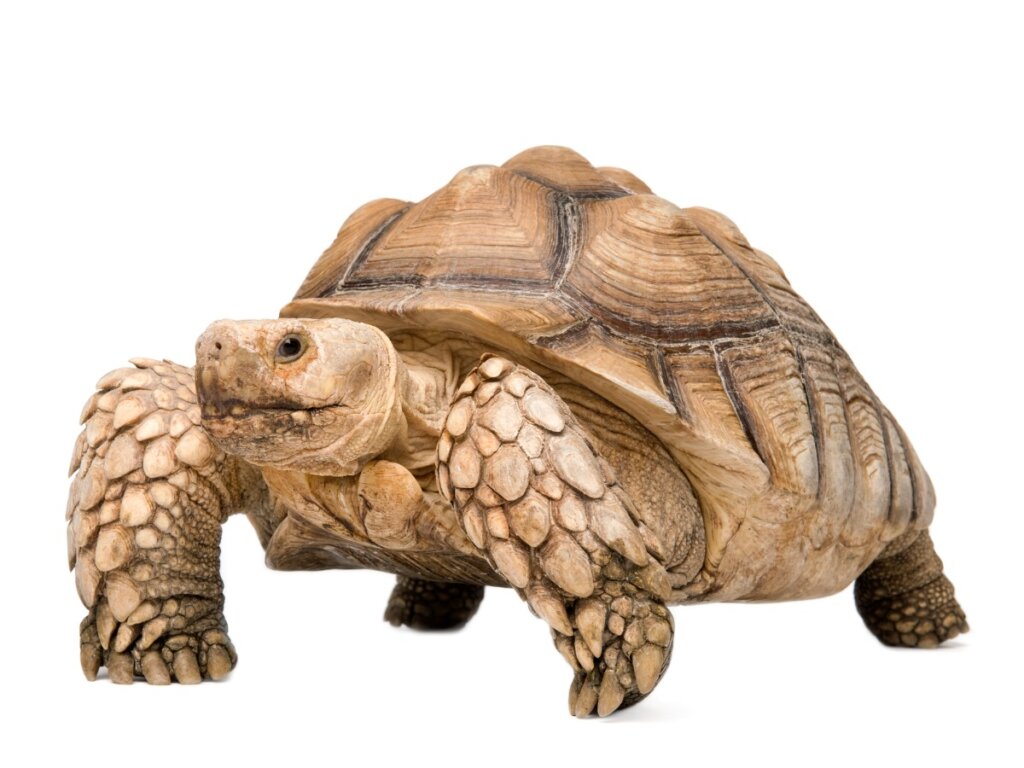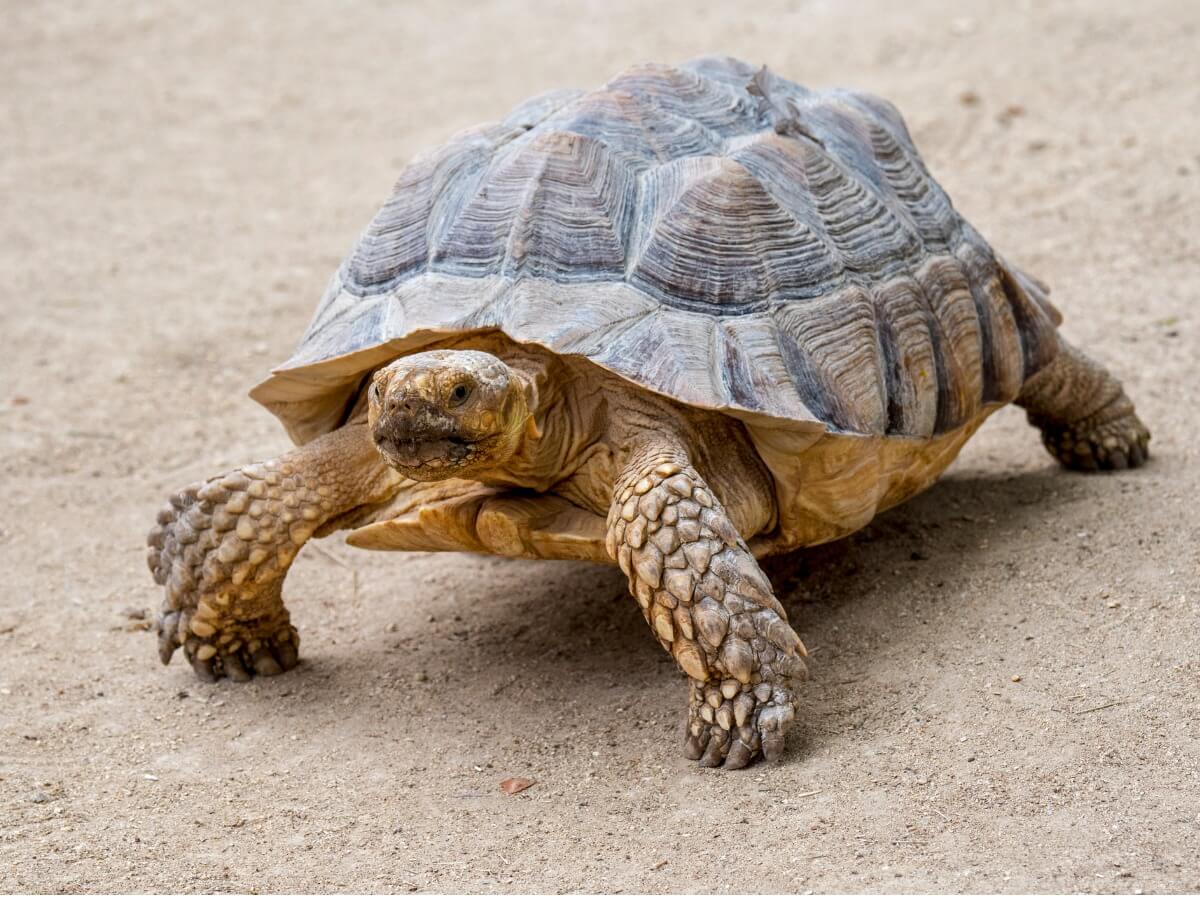Sulcata Tortoise: Habitat and Characteristics

The sulcata tortoise, also known as the African spurred tortoise, is one of the largest species in existence. It has adapted to living in extremely hot environments, with abilities that allow it to conserve water well. In addition, it’s a giant reptile, focused on surviving in the limits of one of the most famous deserts.
Formally, the scientific name of this turtle is Centrochelys sulcata, a sauropsid reptile belonging to the chelonians (testudines). Learn more about this giant from Africa in this article.
Sulcata tortoise habitat
The distribution of this reptile covers the south of the Sahara, from Senegal to eastern Sudan, along the Sahel band. So, it’s located in a strip that crosses the entire African continent, from the Atlantic Ocean to the Red Sea. In addition, this area is known as a transition region between desert dunes and vegetation.
The habitats this turtle lives in are arid and with sandy soils, with quite high temperatures. In these places, rainfall is scarce, so it has to deal with the heat in a particular way. To do this, it digs burrows in order to withstand the long periods of droughts, but also the freezing nights in its environment.
Physical characteristics
It‘s recognized as one of the largest tortoises in the world, second only to the Galapagos tortoises. The length of its shell can reach 85 centimeters (2.8 feet), while its weight exceeds 80 kilograms (176 pounds).
The silhouette of this chelonian’s shell is oval, flattened on the back and with serrated edges. Although the shape of their shields is flat, the margins are folded almost horizontally, which resembles the base of a hat. In this area of its back, the predominant color is brown.
On the other hand, the plates of its belly (plastron) have well-defined divisions, with growth marks and ivory tones. In addition, their skin is quite thick and yellow in color, but with certain shades of brown, which match their natural environment.
This tortoise has a pair of dewclaws on its hind legs, a particular and distinctive feature. These are bumps that stick out of the skin, very similar to bone, and that’s why they call this chelonian the “spurred tortoise”.

Feeding the sulcata tortoise
This land tortoise consumes the little vegetation available in its habitat, which is why it’s considered a phytophagous. What’s more, this behavior helps it to survive, as, thanks to these plants, it can hydrate and store water. Some of the groups that make up their diet are grasses, cucurbits, and dates.
This species of tortoise actually helps the maintenance of vegetation in poor and arid ecosystems. The function of the sulcata tortoise in its environment is to feed on these plants, so that when they defecate, their feces serve as fertilizer for the seeds they ingested. In this way, the vegetation is able to grow again, using the few nutrients available in their environment.
Reproduction of the sulcata tortoise
The males reach their sexual maturity when their shell measures 35 centimeters in diameter (13 inches). Their mating season takes place between September and November, taking advantage of the rainy season. However, this isn’t always the case, as many of the specimens can copulate during the rest of the year, depending on the environmental conditions.
Although it isn’t a complex courtship, sulcata tortoises attract the attention of the female, walking in circles around her and striking her shell. During this moment, the males are quite aggressive with their congeners of the same sex, and there can be quite vicious fights.
After copulation, the female’s body begins to produce eggs and she has to reduce the amount of food she eats. In addition, she nstinctively looks for a good place to make her burrow, digging a hole 14 centimeters deep ( 6 inches) on her own. What’s more, the first few places may not convince her too much and she may have to repeat this process 4 or 5 more times, until she finds the right one.
Finally, when she finds the perfect place, the mother lays 15 to 30 eggs in the nest, to begin the incubation process that will last about 8 months. At this point, the female only covers her eggs to protect them, but doesn’t provide formal maternal care.
Like crocodiles, the sex of this reptile is determined by the incubation temperature. This means that the eggs hatched at cooler temperatures are male, while females will develop in warmer temperatures.
Behavior
These chelonians are quite aggressive, even from the moment they hatch from the eggs, at which point they hit each other to try to turn over. In fact, several of these fights end with bloody heads and necks, especially during the breeding season.
This species likes to dig a lot and is well adapted for it, as it uses this resource to escape the inclement heat. Due to this, they have to be prepared to avoid dehydration, and retreat to the holes they dig, in order to maintain their temperature and protect themselves from the sun. Also, for this reason, they’re at their most active at dusk or dawn.
State of conservation
The population of this animal is in decline, which means that it may be at risk of disappearing. According to the International Union for Conservation of Nature, this species is listed as threatened. This is due to the problems faced by both the reptile and its habitat.
In general, the obstacles that prevent the development of this turtle are the following:
- Loss of its habitat: The area in which this chelonian is distributed faces serious problems of deforestation, agriculture, and urbanization, which complicates the survival of the species. In addition, these same factors have caused the fragmentation of their populations.
- Hunting (consumption): Due to the socio-economic conditions of the locals, the meat of this reptile is used for human consumption.
- Trade: Due to some customs and beliefs, these animals are exported to make remedies that supposedly increase longevity. In addition, it’s also famous among reptile fans, being sold as a pet in several places.
Perspectives
The sulcata tortoise is a beautiful reptile of incredible size that’s in danger of disappearing. Although its decline seems distant, the situation of this species is not good, as it faces socio-economic and political obstacles that are difficult to solve. The only good thing about this is that it can be reproduced in captivity, so there’s still hope for its conservation.
Even so, a species like this disappearing from its natural environment is a catastrophic event for the ecosystem, because it creates an imbalance that isn’t easy to correct.
Each species has a role in nature and they’re all important. For this reason, what we must aspire to is ecological balance with sustainable development, or, in other words, to learn to coexist with others.
All cited sources were thoroughly reviewed by our team to ensure their quality, reliability, currency, and validity. The bibliography of this article was considered reliable and of academic or scientific accuracy.
- Merchán-Fornelino, M., Coll-Montón, M., & Fournier-Zepeda, R. (2002). Crecimiento de la tortuga de espolones Geochelone sulcata Miller, 1779 (Testudines: Testudinidae) durante el primer año de vida. Brenesia., (57/58), 151-156.
- Merchán, M., Coll, M., & Fournier, R. (2005). Macromorfometría de juveniles de Geochelone sulcata (Testudines: Testudinidae) en Costa Rica. Revista de Biología Tropical, 53(1-2), 213-225.
- Ritz, J., Griebeler, E. M., Huber, R., & Clauss, M. (2010). Body size development of captive and free-ranging African spurred tortoises (Geochelone sulcata): high plasticity in reptilian growth rates. The Herpetological Journal, 20(3), 213-216.
- Ligon, D. B., Bidwell, J. R., & Lovern, M. B. (2009). Incubation temperature effects on hatchling growth and metabolic rate in the African spurred tortoise, Geochelone sulcata. Canadian Journal of Zoology, 87(1), 64-72.
- Casimire‐Etzioni, A. L., Wellehan, J. F., Embury, J. E., Terrell, S. P., & Raskin, R. E. (2004). Synovial fluid from an African spur‐thighed tortoise (Geochelone sulcata). Veterinary clinical pathology, 33(1), 43-46.
- Petrozzi, F., Hema, E. M., Luiselli, L., & Guenda, W. (2016). A survey of the potential distribution of the threatened tortoise Centrochelys sulcata populations in Burkina Faso (West Africa). Tropical Ecology, 57(4), 709-716.
- de Buruaga Blázquez, A. S., & San Pedro, Z. (2018). Restos prehistóricos de tortuga de espolones africana en la franja desértica entre el Sahara Occidental y Mauritania. Sautuola: Revista del Instituto de Prehistoria y Arqueología Sautuola, (23), 447-459.
- Avanzi, M., & Millefanti, M. (2019). El gran libro de las tortugas. Parkstone International.
